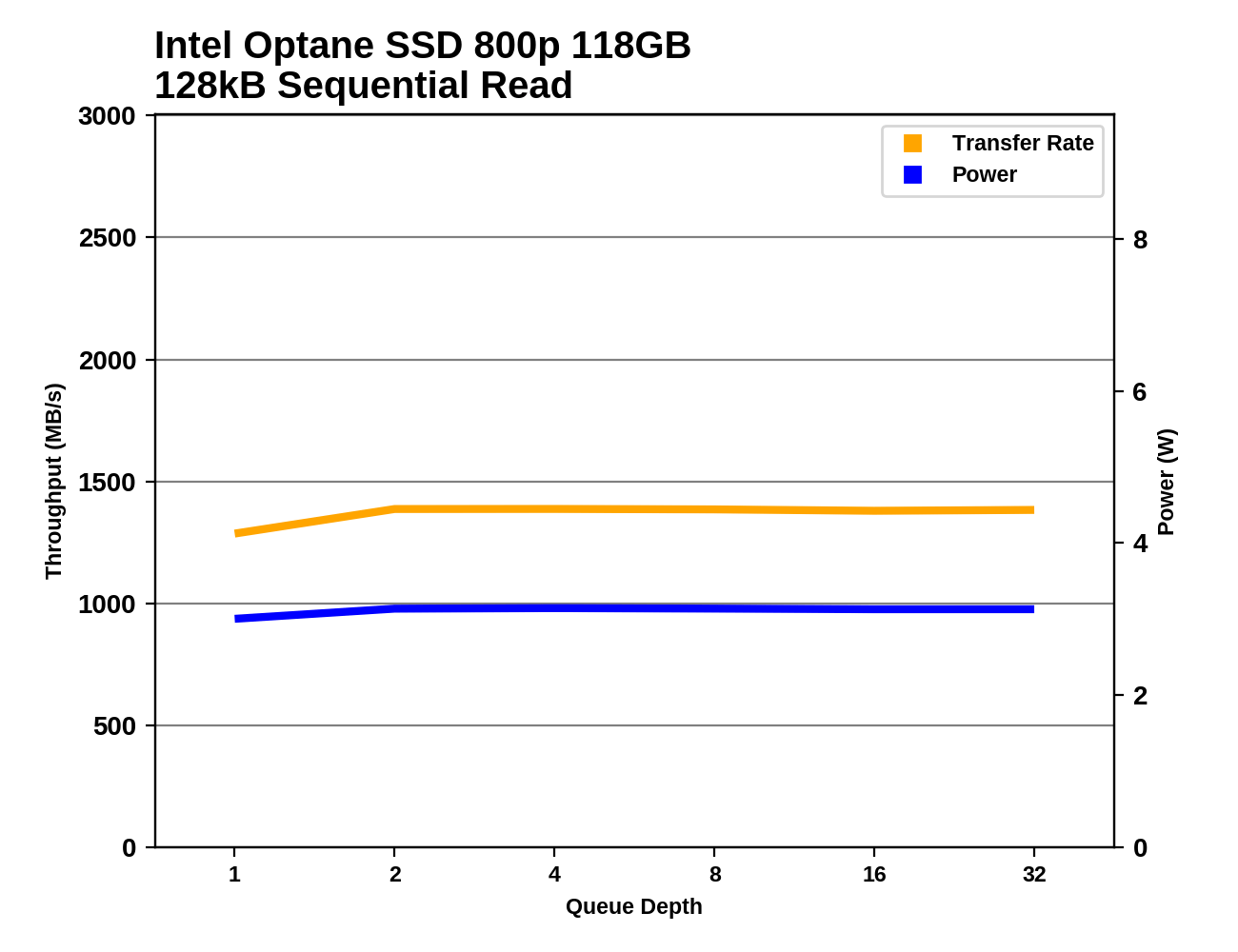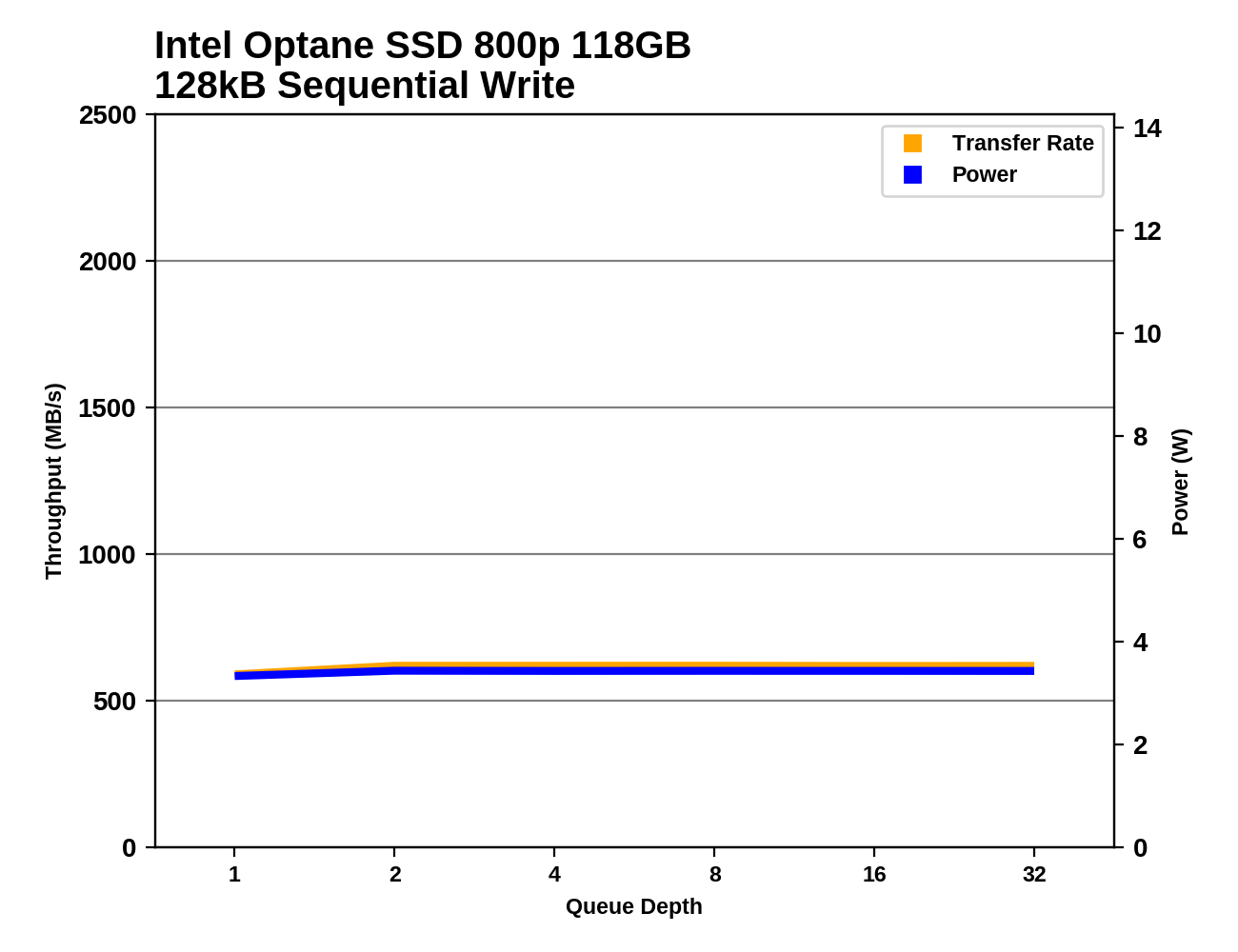The Intel Optane SSD 800p (58GB & 118GB) Review: Almost The Right Size
by Billy Tallis on March 8, 2018 5:15 PM ESTSequential Read Performance
Our first test of sequential read performance uses short bursts of 128MB, issued as 128kB operations with no queuing. The test averages performance across eight bursts for a total of 1GB of data transferred from a drive containing 16GB of data. Between each burst the drive is given enough idle time to keep the overall duty cycle at 20%.

The QD1 burst sequential read performance of the Intel Optane SSD 800p is close to their rated maximum throughput, but they are far behind the 900p and high-end Samsung drives that actually need more than two PCIe lanes.
Our test of sustained sequential reads uses queue depths from 1 to 32, with the performance and power scores computed as the average of QD1, QD2 and QD4. Each queue depth is tested for up to one minute or 32GB transferred, from a drive containing 64GB of data.

On the longer sequential read test, the Samsung NVMe SSDs fall down to the level of the Optane SSD 800p, because the flash-based SSDs are slowed down by some of the data fragmentation left over from the random write test. The Optane SSDs performed those writes as in-place modifications and thus didn't incur any fragmentation. This leaves the Samsung 960 PRO 2TB barely faster than the 800p, while the 900p runs away with its lead.

The Optane SSD 800p has the clear lead in power efficiency, as its second-tier performance comes with far lower power consumption than the top-performing 900p.
 |
|||||||||
There are no big surprises with the queue depth scaling; the 800p's sequential reads are slightly faster at QD2 than QD1, but there's no further improvement beyond that. The 800p is easily staying within its 3.75 W rated maximum power draw.
Sequential Write Performance
Our test of sequential write burst performance is structured identically to the sequential read burst performance test save for the direction of the data transfer. Each burst writes 128MB as 128kB operations issued at QD1, for a total of 1GB of data written to a drive containing 16GB of data.

The burst sequential write speed of the Intel Optane SSD 800p is no better than the low-end flash-based NVMe SSDs. Without any write caching mechanism in the controller, the fundamental nature of 3D XPoint write speeds shows through. The 900p overcomes this by using a 7-channel controller, but that design doesn't fit within the M.2 form factor.
Our test of sustained sequential writes is structured identically to our sustained sequential read test, save for the direction of the data transfers. Queue depths range from 1 to 32 and each queue depth is tested for up to one minute or 32GB, followed by up to one minute of idle time for the drive to cool off and perform garbage collection. The test is confined to a 64GB span of the drive.

The Optane SSD 800p looks better on the sustained sequential write test, as all the TLC-based SSDs run out of SLC cache and slow down dramatically, while the Optane SSDs keep delivering the exact same performance.

Despite their very different sequential write throughput, the Optane SSD 900p and 800p end up with very similar power efficiency on this test. The Samsung NVMe drives are even more efficient, but only the premium MLC-based 960 PRO has a large lead.
 |
|||||||||
Almost all of the drives show no performance scaling with increasing queue depth, as large-block sequential writes can keep all the memory channels busy with only a little bit of buffering. The 900p needs at least two 128kB writes in flight to reach full throughput.










116 Comments
View All Comments
eddman - Monday, March 12, 2018 - link
90? It is stated as 20nm in that table up there.Nottheface - Monday, March 12, 2018 - link
I was told these are not related in a previous article's posts: https://www.anandtech.com/comments/12136/the-intel...Ewitte12 - Monday, April 30, 2018 - link
They had difficulty keeping the enterprise drives in stock.The 2X quote was for RAM. low queue depth obliterates NAND. Most other speeds are on par with NAND (with sustained a bit behind) but this is direct access to the storage. Most NAND drives have sophisticated RAM caching it can be writing way after the bar disappears off your screen.
The biggest issue with pricing. Optane has high early adopter fees (which come with a few extra bugs usually). Also anything under the 900p is kinda pointless. 3.0x2 and low capacities??? Not worth it.
Gothmoth - Friday, March 9, 2018 - link
intel hyped this like crazy and after reading the paper i was hyped too.but this seems like just another way for intel to push it´s stock market value with redicolous claims.
hescominsoon - Friday, March 9, 2018 - link
Semiaccurate had 3d x-point pegged from the beginning:https://www.semiaccurate.com/?s=point
Ashinjuka - Saturday, March 10, 2018 - link
Optanic.DanNeely - Thursday, March 8, 2018 - link
Could we see results from Optane as cache + budget SSD and Optane as cache + high end SSD?I'm not sure it'd be worthwhile with a fast SSD since it only beats them in a subset of benches, but it looks capable of giving a decent boost to budget flash. Cost effectiveness vs just buying better flash'd be the harder question.
iter - Thursday, March 8, 2018 - link
Cache only makes sense for a HDD. It would make no difference combining it with an SSD. Not in terms of real world application performance anyway.Spending on 118 gb of optane is pointless when you can get a decent 512 gb ssd for the same money. Over 200% higher the capacity at 99% of the performance. It is a no brainer. Intel will have to resort to bribing OEMs once again if they are to score any design wins.
patrickjp93 - Saturday, March 10, 2018 - link
Uh, think again on big data where the indices for the databases you're running are way too big to fit in memory. AWS is just one cloud provider making extensive use of Optane, especially in DynamoDB, RDS, Memcached, and Lambda where multi-tenant container environments definitely benefit in rapid spinup thanks to the much lower latency 3DXP.Billy Tallis - Thursday, March 8, 2018 - link
All of our usual SSD tests are for the drive acting as a secondary drive, but Intel's Optane-specific cache software only supports the boot volume, so it's rather awkward to test.